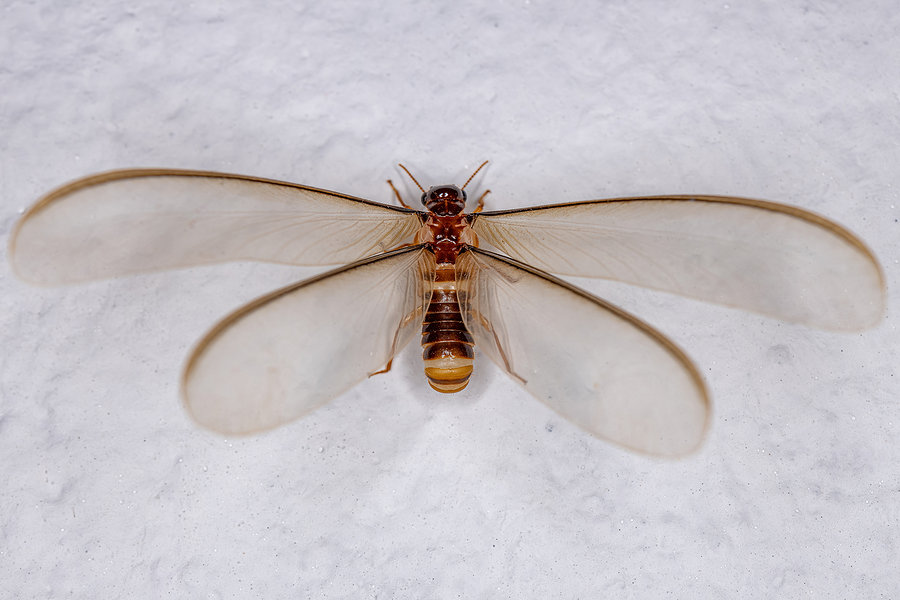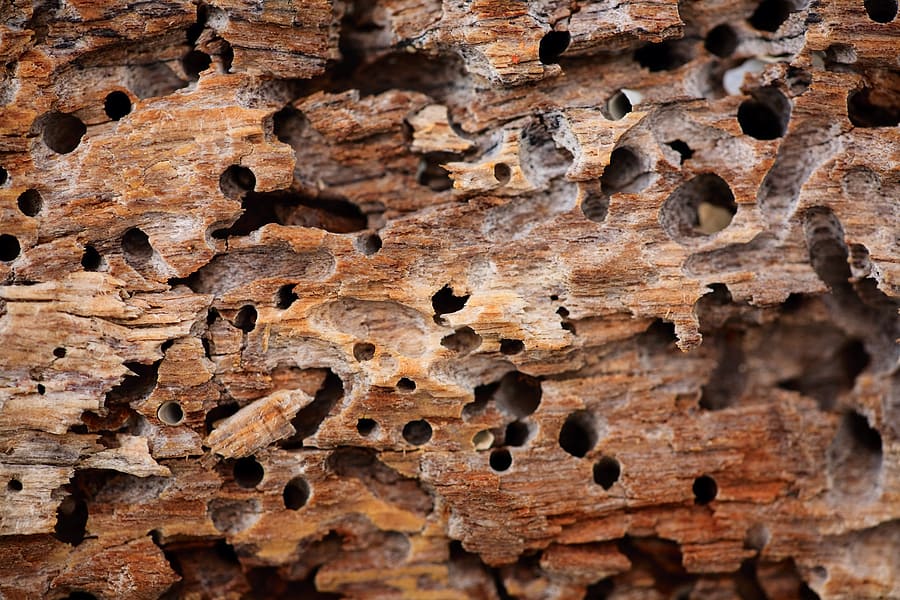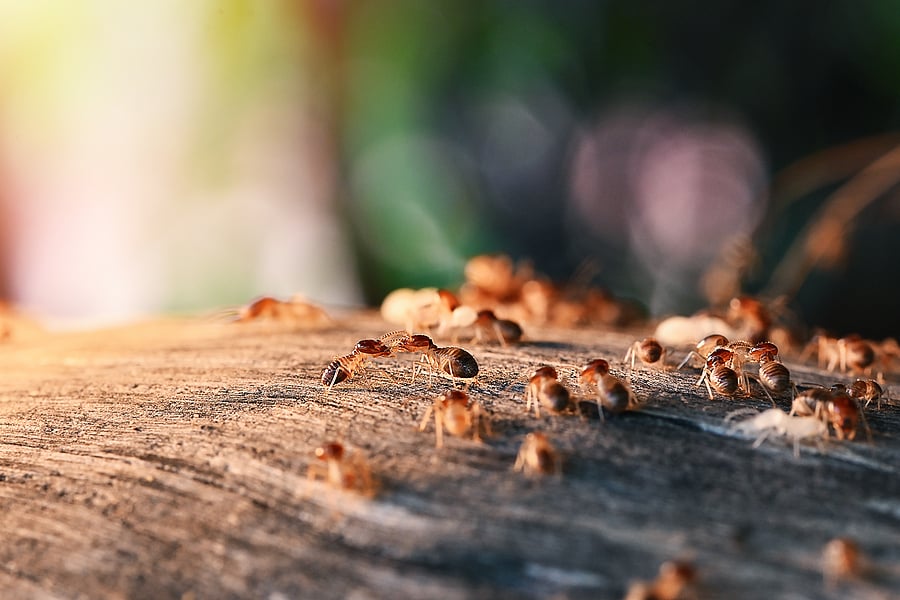READY TO GET STARTED?
REQUEST A FREE ESTIMATE
Fill out the form below or call (888) 466-7849 for a free, no-obligation estimate.

It’s Termite Awareness Week, and termites are a known threat to southern homeowners. Termites can cause more than 5 million dollars in property damage throughout the United States, and it is normal for this damage not to be covered by homeowner’s insurance policies. Before the damage gets out of control, look for termite signs and consider getting a preventative termite treatment and warranty from professional help.
One of the first signs that termites are near is if you encounter swarmers near your home. Although swarmers do not cause wood damage, they do indicate that a colony is nearby. If you notice swarmers, it’s best to take immediate action and have a local termite control company take a look.
Another tell-tale sign that termites are close by is the presence of mud tubes or tunnels along the foundation of your home. Termites use mud tubes to keep moisture when traveling to and from their colony and your home.
Some other signs of termites that you may notice are:
Even if you do not find signs of termites, now is still the perfect time to get preventative termite protection! With the Sentricon Always Active bait system, you’ll experience 24/7 termite protection, annual inspections, a lifetime termite warranty, and more! Reach out to your local pest control company to help identify the type of termite and recommendations on the best treatment plan.

Swarming termites, also known as alates, are termites with wings that leave their colonies with two purposes in mind: reproducing and establishing a new colony. Alates resemble flying ants and will colonize anywhere with a cellulose source and adequate moisture for survival, making your home the ideal environment for a new colony. While alates don’t bite, sting, or eat wood, they are a good indication that there is a termite colony nearby.
Once the original termite colony reaches capacity and is ready to expand, termite swarms occur. These usually happen once per year, although some species will swarm multiple times. Swarms can contain anywhere from hundreds to thousands of alates whose sole purpose is reproduction and expansion of the colony. Once environmental conditions are right, the swarmers will launch themselves into the air and pair off. Once they’ve found their partner, both will shed their wings, mate, and find a new place to nest.
The timing of termite swarms depends on the type of termite you are dealing with. Subterranean termites typically swarm in the spring during daylight hours. Drywood termites swarm in late summer and early fall, and dampwood termites swarm over the summer. Termites will swarm once conditions are ideal, usually the day after a rain shower with overcast weather and winds less than 6 mph. Damp soil after a rainstorm also helps with nest building.
If a colony is already established inside your home, termites may swarm inside. These alates will try to squeeze through cracks and crevices in your foundations and walls to reach open air. Alates are also attracted to light so they can often be found near windows and light fixtures.
Termite swarms vary depending on what species it is. Drywood termite swarms are usually smaller than other termites with less than 100 swarmers. They will swarm in late summer and fall. Due to the small size of the swarm, you may not see the signs of drywood termites until they are already established. Dampwood termites swarm in the summer months. They are of less concern to homeowners as houses don’t typically have the moisture content necessary for them to survive. They can, however, be found in wood structures surrounding homes, e.g. utility poles. Subterranean termites are the most common and have the largest swarms, sometimes numbering into the thousands. These termites swarm in the spring between March and June.
While swarms don’t necessarily mean you have a termite infestation in your home, they are a good indicator that there is a thriving colony nearby. If you spot swarming termites in or near your home, consider a termite inspection to help identify signs of termites you may have missed and ensure you don’t have a hidden colony eating your home from the inside out.
If you suspect termites, contact a professional pest control company who can give your house a thorough inspection and help with a termite control and prevention plan going forward.
How Do I Know if I Have Bed Bugs?
Preparing Your Lawn for Spring
Millipede vs Centipede – Which Is More Dangerous?
The first step in termite prevention is to be ready for them. One of the most important things you can do is learn the signs of termites in order to catch them early. Termites can often go undetected for long periods of time, causing significant damage before you are alerted to their presence. The most common types of termites include subterranean termites, drywood termites, and Formosan termites. The type of termite and the location of the infestation help determine the best type of termite treatment to use. Here are four of the most common termite treatments utilized by termite control professionals.
Pretreatments are termite treatments that are performed during the building phase of new construction. It is also preferable to utilize pretreatments when constructing additions on an existing home, as well. Pretreatments are more effective and affordable when utilized before the physical infrastructure of a home or addition is laid. Pretreatments involve a combination of liquid termiticide (commonly containing borates), termite bait, lumber treatment, and in soil barriers.
Barrier treatments form a literal barrier in the ground between termites and your home. A trench is dug around the perimeter of your home and the soil that is removed is treated heavily with a termiticide. The trench is then refilled with the treated soil. In some cases, a physical wall is also constructed inside the outer wall of the trench made up of rock, sand, mesh, and plastic. This adds an additional layer of protection between your home and termites.
Liquid treatments are the most common termite treatments utilized. These treatments are effective for termite infestations on the interior of your home. In these treatments, holes are drilled strategically in both the foundation and the wood. Termiticide is then injected into the holes which forces the termites to emerge. The termites are then exterminated by spot treatments with termiticides.
In these treatments, bait stations containing wood, paper, or cellulose that is laced with termiticide are placed in the ground around your home. Termites are attracted to the bait and eat it. The termiticide is slow acting which allows the termites to return to the colony and spread the bait to others, killing off the entire colony. Bait stations can be used in locations where surface treatments can’t, such as near foundation drains and areas that are covered by slabs or flooring. Bait stations are an effective and long-term treatment solution.
Termites can get out of control quickly and be incredibly difficult to eradicate. If you suspect you have a termite problem, contact your local pest control company for a termite inspection to identify the type of termite and recommend the best course of treatment.
5 Pests That Can Destroy Your Lawn
Why Are Cockroaches So Resilient?

One of the most important things a homeowner must do is protect the wood within their structure. Two of the most common causes of wood damage in a home are wood rot and termites. Both of these can cause significant damage by going undetected for long periods of time. Signs of wood rot and termite damage are similar, often making it difficult to determine what type of problem you have. It is important to know which of these you are dealing with in order to properly resolve it. Here are some signs of termites and wood rot and how to tell the difference between the two.
There are two types of wood rot: dry rot and wet rot. Dry rot is caused by fungi that attack wood, destroying it from the inside out. Dry rot can affect any untreated wood that has a 20% moisture content. This type of rot spreads quickly and is also known as brown rot. Wet rot is common in homes that have a preexisting moisture problem such as a leak around an air conditioner, a malfunctioning downspout, clogged gutters, leaky faucets, or shrubs that are too close to the house. With wet rot, the surface veneer of the wood is impacted so it is usually easier to spot. Wet rot can affect any unprotected wood. It tends to be more localized than dry rot and doesn’t spread as much.
Some common signs of dry wood rot include:
Some common signs of wet wood rot include:
Subterranean termites are one of the most common types of termite, although drywood termites can also cause significant damage. Termites eat cellulose that is present in wood, hollowing them out from the inside out. Termites access your home through cracks in the foundation and walls. Because termites eat from the inside out, they can often go long periods of time undetected.
Some common signs of termite damage include:
Whether you have wood rot or termites, the most important thing is to recognize the issue and get it resolved as quickly as possible. If you have an issue with termites or any other pests, contact your local pest control company for a free analysis and treatment plan.
The Importance of Commercial Pest Control
Fact or Fiction: Mothballs Keep Snakes Away

Spring and early summer mark the start of termite swarming season. Swarming termites, also known as alates, are classified as nuisance pests because although they can be bothersome to have around, they cannot bite, sting, or even chew wood. They do, however, signify the presence of an established termite colony nearby which can be problematic for you and your home.
Termites are silent destroyers, often causing significant damage and destruction to your home for long periods of time while going undetected. Learning the signs of termites, including the presence of swarms, is a critical first step in termite prevention.
When dealing with termite swarms, several questions are posed: When is swarming season? Where should I look for swarms? Can these swarms cause damage? Why are they swarming? How can I prevent them?
This question depends on what type of termite you are dealing with. Subterranean termites begin their swarming season in the spring, usually during daylight hours. Drywood termites, on the other hand, don’t swarm until late summer and early fall. Dampwood termites tend to swarm during the summer months. The weather also plays a factor into when termites will swarm. Each species has its own set of conditions that are ideal for swarming but most of them will start the day after a rainstorm when the weather is still overcast and there is little to no wind.
While termite swarms can be found both indoors and outdoors, they cannot survive indoors because of the lack of soil in which to colonize. Swarming termites can be found anywhere termites colonize. If they do make their way indoors, they can often be found near windows and light fixtures as they are attracted to the light.
Termite swarms themselves usually do not cause damage. Swarming termites cannot bite, sting, or chew. As termites get ready to swarm, they make a tube which they use to launch. When conditions are ideal, they use the tube to launch themselves. After a brief flight of only a few seconds, the termites land and break their wings away from their bodies and pair with a mate. Those pairs that survive then create a chamber underground that they use to breed and the new colony is formed. Swarm launches are usually spread out over a few days with a large release on the first day and smaller launches on subsequent days. Termite swarms can indicate the presence of an existing colony nearby so while the swarmers themselves may not cause damage, the nearby colony can.
The primary purpose of termite swarms is reproduction and expansion of the colony. When the original termite colony reaches capacity and needs to expand then the swarming process begins, usually occurring once per year. The number of termites in each swarm varies depending on which type of termite species is swarming and the size of the colony.
In order to prevent termite swarms, one must prevent termite colonies from establishing nearby. Prevent termites by:
Because a termite swarm indicates a nearby colony, homeowners should take precaution when one is spotted nearby. If you suspect you have a termite infestation, contact a professional pest control company who can inspect your property and set up a termite control plan.
7 Snakes You May Encounter This Summer